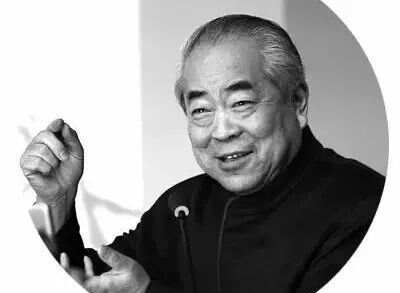
范曾先生是当代画坛巨擘,或以开拓求新为时尚,或以固守传统为荣,都无法解释他。他接受过严格的学院训练,这使他的造型手段迥然不同于传统中国画家。他浸染传统之深,使他的笔墨技巧达到了极高的水准,甚至使古人瞠乎其后。他博学多才,“致广大而尽精微”,又使他的画面富有诗的意蕴境界。
Mr. Fan Zeng is a giant in the contemporary painting world, and it is impossible to explain him either by the fashion of pioneering and seeking newness, or by the pride of sticking to tradition. He has received rigorous academic training, which has made his stylistic approach very different from that of traditional Chinese painters. His deep immersion in tradition has brought his brush and ink skills to an extremely high level, even to the point of making the ancients stare in disbelief. His versatility and erudition, and his ability to "realize the vast and exhaust the subtle," make his paintings rich in the realm of poetic meaning.
范曾精于白描,摒弃打轮廓描摹,尤喜写意人物。为表现历史人物之神韵,他潜心研究历史,悉心揣摩古今中外诸名家之作,他特别推崇陈老莲和任伯年。范曾的历史人物画清新典雅,潇洒飘逸,诩诩如生,呼之欲出,风骨独具。亦擅作泼墨人物,力追古代梁楷、法常诸人,笔墨浑厚,造型生动,继承了南宋梁楷以来简笔泼墨的手法,形成了自己独特的风格,开人物画一代风气之先。
Fan Zeng specialized in white drawings, abandoning outline depictions, and was especially fond of writing characters. In order to express the charisma of historical figures, he studied history and scrutinized the works of famous artists in the past, present and future, and he particularly admired Chen Laolian and Ren Bonian. Fan Zeng's paintings of historical figures are fresh and elegant, dashing and elegant, and he boasts of his unique style of living and breathing. He was also good at making ink-splashed figures, and he tried to follow the ancient Liang Kai and Fa Chang, with thick ink and brushwork and vivid modeling, inheriting the simple ink-splashed brushwork of Liang Kai of the Southern Song Dynasty, and forming his own unique style, which was the first of its kind in the figure painting generation.

范曾的“物华天宝;禅茶一味”笔法灵动,线条瘦劲有力,结字俊朗,清新宜人。
Fan Zeng's "Things Huatianbao" has a dynamic brushwork, lean and powerful lines, and handsome and fresh characters.
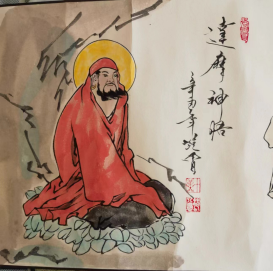
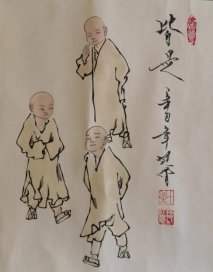
《达摩神悟图》当是范曾先生的得意之作。头、脚等局部细笔出之,而衣服则用减笔法,粗细结合,相互生发,相得益彰。画者将人物置放在一个旷远的空间之内,全无松石之背景,而读之却发现达摩的悠闲超脱心境展露无遗。
The "Dharma Enlightenment Painting" is Mr. Fan Zeng's best work. The head, feet and other parts of the fine brush, while the clothes with reduced brushwork, thick and thin combination, mutual development, complement each other. The artist has placed the characters in a remote space, without the background of pine and rocks, while reading it, he finds that Dharma's leisurely and transcendent state of mind is revealed.
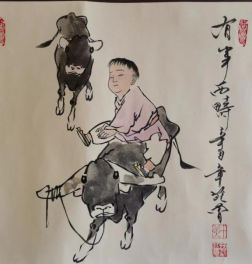
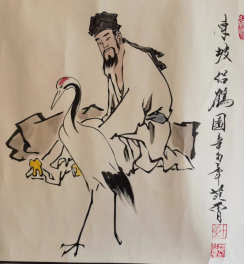
此幅作品中,童子牵牛而往,洋溢着春意盎然、朝气蓬勃的气氛,是范先生的典型构图。值得注意的是,范先生的绘画作品,构图是颇讲究的,注重空间布置,人物之间、人物与其他动物或者物件之间,有前后、上下、左右的穿插关系,在互相掩映参差之中,有了场景的真实感。此乃中国画的高妙之处,虽是散点透视,虽是在二维平面之间造型,但一定要有空间的造境感,否则,总不能超脱一般笔墨的层次,实现气韵生动的追求。
In this work, a child is leading a cow to a place that is full of spring and vigor, which is typical of Mr. Fan's compositions. It is worth noting that Mr. Fan's paintings are quite elaborate in composition, focusing on spatial arrangement, with interspersed relationships between figures, and between figures and other animals or objects, such as front and back, up and down, and left and right, which give a sense of realism to the scene in the midst of the mutual concealment of the differences. This is the high point of Chinese painting, although it is scattered perspective, although it is modeling between two-dimensional planes, but there must be a sense of spatial context, otherwise, it can not transcend the general level of ink and brush, to achieve the pursuit of the vividness of the chiaroscuro.
其牛以没骨法绘成,墨气较活,只用浓墨勾出角、嘴、眼、蹄、尾等部位,孩童身体先用简洁干脆的墨线勾出,再设单色,颜色明亮清爽,一实一虚,一浓一淡,加强了整体气氛的传达和技法的对比。这幅画虽没有松石等背景,但仍然可以感受到牧童游戏于自然田园的快乐和趣味。这种不画之画、不写之写正是这幅画的魅力所在。虽尺幅不大,用墨不多,春暖大地的气息却扑面而来。
The cow is painted by the boneless method, the ink is more active, only use the thick ink to outline the horns, mouth, eyes, hooves, tail and other parts of the child's body with simple and dry ink line outlined, and then set up a monochrome, the color is bright and refreshing, a real and a virtual, a thick and a light, strengthening the overall atmosphere of the conveyance and the contrast of the techniques. Although there is no background such as pine and rocks in this painting, you can still feel the joy and fun of the shepherd boy playing in the natural idyll. This kind of painting without painting and writing without writing is exactly the charm of this painting.
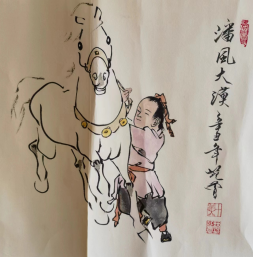
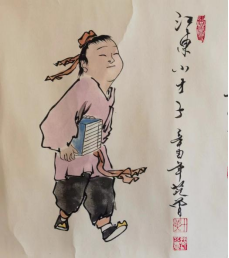
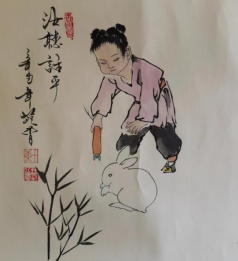
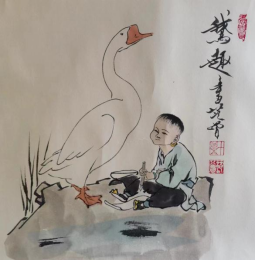
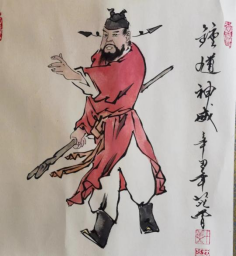
范曾先生所绘钟馗,不同于古人,他把文与武两重形象同时赋予给钟馗,既给他以威猛,也给他以庄严。对这一传统题材作了独具匠心的艺术改造,即不去刻画钟馗将小鬼“刳目而啖之”的可怖,而着力表现其“内圣外王”的人文内涵。于是钟馗不再是凶恶骇人的“鬼”,而是有血有肉、有爱有憎的“人”,既端庄威严又可敬可亲。钟馗成为范曾艺术世界中的一个重要符号,给了他恒久的艺术生命。范曾画钟馗已有40年历史。他的威风凛然、精光四射的钟馗形象已广为世人所喜爱,他本人最初也因钟馗而声名鹊起。
Mr. Fan Zeng's painting of Zhong Kui is different from that of the ancients, in that he has given Zhong Kui both a literary and a martial image, giving him both majesty and solemnity.This traditional subject has made a unique artistic transformation, that is, instead of portraying the horror of Zhong Kui's "routing out the eyes and mouths" of the little ghosts, he focuses on expressing the humanistic connotation of his "inner saint and outer king".As a result, Zhong Kui is no longer a vicious and horrifying "ghost", but a "human being" with flesh and blood, love and hate, who is both dignified and majestic, as well as respectable and approachable.Zhong Kui has become an important symbol in Mr. Fan Zeng's art world, giving him a constant artistic life.Fan Zeng has been painting Zhong Kui for 40 years.His powerful and brilliant Zhong Kui image has been widely loved by the world, and he himself was initially famous for Zhong Kui.
文中的作品系范曾经典之作,画中用充满激情的画笔,寥寥几根线条以及衣物大面积的彩色准确而又生动地勾画出这位刚正不阿,正气浩然的中国传统文化中“赐福镇宅圣君”钟馗的形象。范曾有时会抓住钟馗的特点进行表现:此幅钟馗立身前行,人物相貌魁梧,五官端正,衣角飘逸,充分显出运动人物的动态。
The works in this article are Fan Zeng's classic works, in which he accurately and vividly sketches the image of Zhong Kui, the "blessing and house-keeping saint" of traditional Chinese culture, with passionate brushes, a few lines, and large areas of color in his clothing.Fan Zeng sometimes captures the characteristics of Zhong Kui in his performance: in this painting, Zhong Kui is standing up and walking forward, with a stout appearance, straight features, and flowing clothes, fully revealing the dynamics of the moving figure.